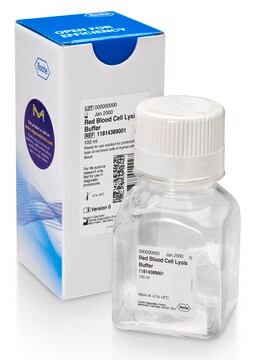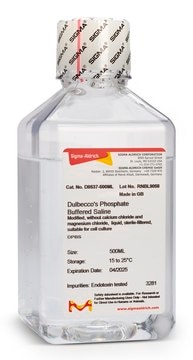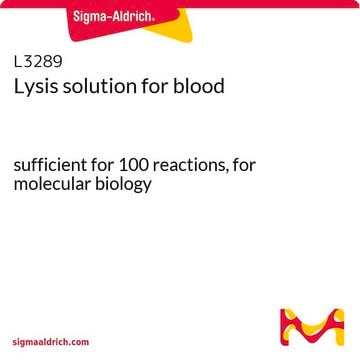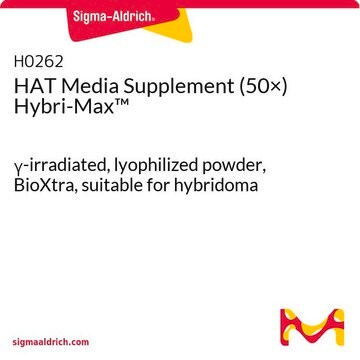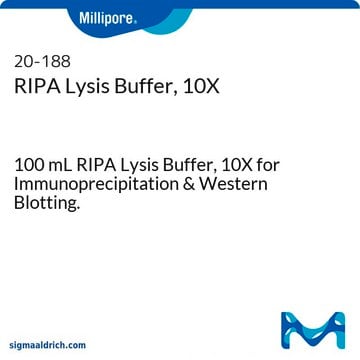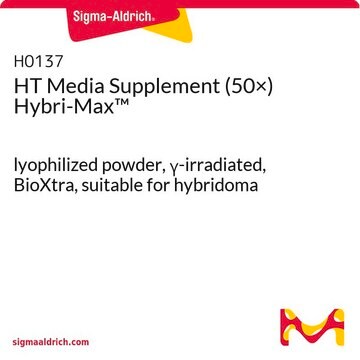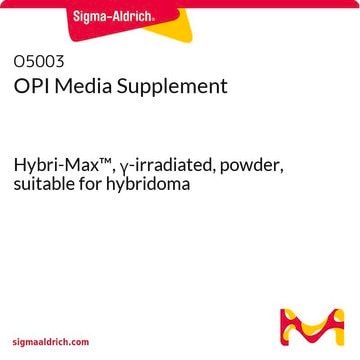추천 제품
제품명
Red Blood Cell Lysing Buffer Hybri-Max™, liquid, sterile-filtered, suitable for hybridoma
무균
sterile-filtered
Quality Level
양식
liquid
기술
cell culture | hybridoma: suitable
불순물
endotoxin, tested
애플리케이션
Recommended for use by adding 1 mL of buffer to a cell pellet (cell pellet = 1 spleen or 100-200 million cells). Gently mix for 1 minute. Dilute the buffer with 15-20 mL of medium or salt solution. Centrifuge at 250-500 × g for 7 minutes and decant the supernatant. Cells may be diluted and prepared for counting or fusion. If lysis is incomplete, steps 1-4 may be repeated.
생화학적/생리학적 작용
Red Blood Cell Lysing Buffer has been developed for use in hybridoma protocols to remove red blood cells from mouse splenocyte suspensions before fusion. It is also useful in systems where it may be desirable to remove red blood cells from cell suspensions, such as whole blood.
성분
Contains 8.3 g/L ammonium chloride in 0.01 M Tris-HCl buffer.
기타 정보
Note: This product is intended for the removal of red blood cells from mice. This product may not be appropriate for the lysis of red blood cells of other animals. The suitability of the product in any application other than mouse splenocytes must be determined by the researcher.
법적 정보
Hybri-Max is a trademark of Sigma-Aldrich Co. LLC
Storage Class Code
12 - Non Combustible Liquids
WGK
nwg
Flash Point (°F)
Not applicable
Flash Point (°C)
Not applicable
이미 열람한 고객
Christopher J M Piper et al.
Cell reports, 29(7), 1878-1892 (2019-11-14)
Regulatory B cells (Bregs) play a critical role in the control of autoimmunity and inflammation. IL-10 production is the hallmark for the identification of Bregs. However, the molecular determinants that regulate the transcription of IL-10 and control the Breg developmental
John M Furgason et al.
Mutagenesis, 29(5), 341-350 (2014-08-12)
Next generation sequencing has become a powerful tool in dissecting and identifying mutations and genomic structural variants that accompany tumourigenesis. Sequence analysis of glioblastoma multiforme (GBM) illustrates the ability to rapidly identify mutations that may affect phenotype. Approximately 50% of
H Guan et al.
Oncogenesis, 4, e166-e166 (2015-09-08)
Recent advances have highlighted profound roles of FOXO transcription factors, especially FOXO1, in bone development and remodeling. The regulation of bone development by FOXOs seems to be stage-specific or context dependent. FOXOs promote maintenance and differentiation of early progenitors of
Iris Boraschi-Diaz et al.
Cytotechnology, 68(1), 105-114 (2014-09-24)
Osteoclasts are responsible for physiological bone remodeling as well as pathological bone destruction in osteoporosis, periodontitis and rheumatoid arthritis, and thus represent a pharmacological target for drug development. We aimed to characterize and compare the cytokine-induced osteoclastogenesis of bone marrow
Lixing Zhang et al.
Cellular signalling, 29, 41-51 (2016-11-05)
Recent evidence suggests that mammary cells expressing R-spondin receptor and Wnt pathway regulator Lgr5, regarded as a stem cell marker in multiple tissues, might represent mammary stem cells (MaSCs). Whether L gr5 marks a multipotent subpopulation of Lin-CD24low/medCD49fhigh MaSCs remains
자사의 과학자팀은 생명 과학, 재료 과학, 화학 합성, 크로마토그래피, 분석 및 기타 많은 영역을 포함한 모든 과학 분야에 경험이 있습니다..
고객지원팀으로 연락바랍니다.